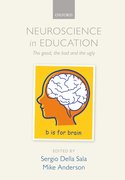By Sergio Della Sala & Mike Anderson
In the past ten years, there has been growing interest in applying our knowledge of the human brain to the field of education, including reading, learning, language, and mathematics. Teachers themselves have embraced the neuro revolution enthusiastically. A recent investigation in the US-based journal Mind, Brain, and Education showed that almost 90% of teachers consider knowledge about brain functioning relevant for the planning of education programmes.
This has resulted in the development of a number of new practices in education: some good, some bad, and some just crazy. Too often, people with the clout to make decisions about which practice is potentially profitable in the classroom setting, ignore evidence in favour of gut feelings, the authority of ‘gurus’, or unwarranted convictions. In short, opinions rather than data too often inform implementations in schools. Hence we have had theories suggesting that listening to Mozart can boost intelligence, foot massages can help unruly pupils, fish oil can boost brain power, and even the idea that breathing through your left nostril can enhance creativity! Sadly, it is often scientists themselves who promulgate unsubstantiated procedures.
We shouldn’t ignore the good practices and innovations in education thanks to the developing neuro revolution. A popular example might be the neuroscience data suggesting a strong neural link between fingers and numbers. This is testified by the observation that 6 year old children who are good in recognizing their fingers when touched will later also be better at arithmetical performances. However, more often than not “the good” classroom developments are actually centered around more mainstream cognitive findings. One such finding, named spaced practice, has been replicated many times; it shows that distributing learning over time is more efficient than massing it all together. For example, if students stockpile learning just before an exam, they may do well enough, but if they want to retain the material in the long term, then retrieving it via multiple tests is much better.
Inevitably, we are drawn to discussing “the bad” developments: one of our favourite examples is the use of ineffective coloured lenses to aid reading. This and several other unproven “aids” are potentially damaging the whole idea that knowledge of the mind-brain may contribute to efficacious educational practice. And of course much of current enthusiasm for neuroeducation involves ugly mistranslations of excellent research into an educational arena. Take for instance the misapplication of the well developed theory of reading (the so called dual-route theory) which has been caricatured and wrongly applied in education to justify an ideological stance from teachers preferring a whole-reading (or holistic) approach at the expense of phonics-based teaching. Briefly, the dual-route theory says that single-word reading can be accomplished through a route of letter to sound conversion (phonics) or through a route of direct visual recognition (whole word reading). It does not say that both are equally effective in teaching children to read. Indeed, several studies have demonstrated that phonics is a more effective method; yet the holistic approach to learning to read rages in the classrooms.
The neuro- prefix is very fashionable nowadays, and neuroeducation is just one of the myriad offsprings. Neuroscience offers an invaluable contribution to assess, diagnose, and perhaps manage pathologies, including pathologies of learning in children and adolescents. However, neuroscience as such has so far proved to have little to offer to everyday, normal education. The discipline which has most to offer is instead cognitive psychology, and from this comes some of the “good” that scientists could endow education with. Some of the findings from cognition are solid and counter-intuitive; for example, retrieval practice that, though receiving little support by pedagogists, has proved effective in improving pupils’ learning. This practice is based on the finding that retrieving material through several testing enhances learning of that material more than studying it over and over again.
The psychology of learning could prove efficacious in an educational context. However, science should never be prescriptive; it offers possible windows of knowledge which may or may not be applicable or relevant in specific contexts such as the classroom. There are no ready-made recipes when it comes to mastering the relevance of brain functioning to teaching today. The last thing teachers need is to be superficially trained in neuroscience, but they should certainly watch this space.
Sergio Della Sala is a Clinical Neurologist, Professor of Human Cognitive Neuroscience at the University of Edinburgh, UK. He is co-editor with Mike Anderson of Neuroscience in Education: the good, the bad, and the ugly, and editor of Cortex. His research focuses on the cognitive deficits associated with brain damage.
Mike Anderson is a Professor of Psychology and Director of the Neurocognitive Development Unit at the University of Western Australia. His research focuses on the influence of the developing brain on intellectual functions in children.
Image credit: Photograph of boy studying by Lewis Wickes Hine, ca. 1924, via Library of Congress, Prints & Photographs Division, National Child Labor Committee Collection, [image number nclc.05276].





[…] este otro nos recuerda que distribuir el aprendizaje en el tiempo es mejor que apretarlo todo junto en un […]